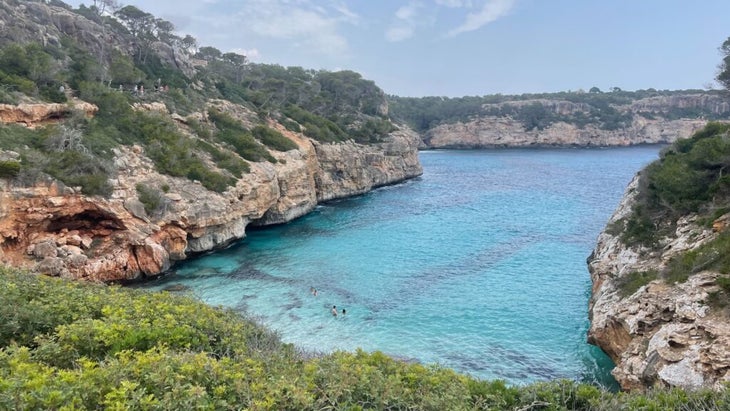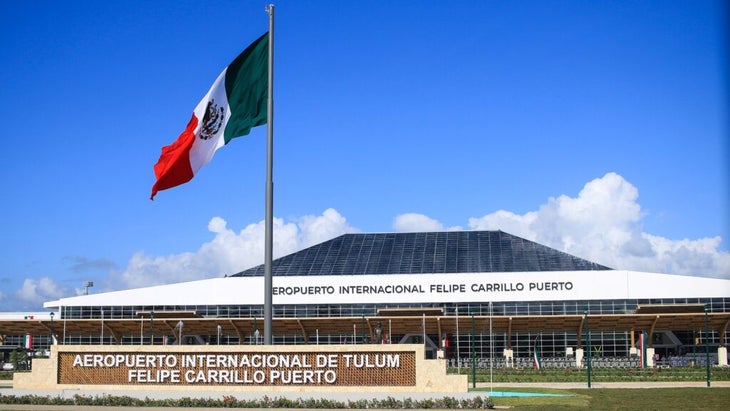Travel is so expensive post-pandemic. But I don’t want to give up the idea of an annual vacation. How can I keep costs down? —Tripping Out Over Expenses
Experts predict that this year will be the busiest ever for travel since before the pandemic. And for many, it’s already feeling like it might be the priciest. According to NerdWallet’s February 2024 travel inflation report, the cost of hotels, entertainment, and dining out are rising, with overall travel expenses for the past 12 months up 3.1 percent through January 2024 compared to pre-pandemic levels.
Hotels will be a big vacation investment. Lodging rates increased 5.2 percent between December 2023 and January 2024 alone. And traveler beware: the average daily hotel rate is projected to grow nearly 5 percent more in the next year, according to hotel-commerce platform SiteMinder. There’s been little respite from room rates hovering near all-time highs at properties across the U.S. this winter, and staff shortages will likely mean continued high prices but fewer services. You’re getting gauged even more for dining out: in January, prices for restaurant meals were 25.6 percent higher than the same month four years ago.

There is some good news: airfare—on domestic routes in particular—is predicted to drop 16 percent this year, according to Kayak. The travel-research engine estimates it will cost $461 on average to fly in the U.S. I recently booked a round-trip, direct flight from Denver to Newark, New Jersey, in April on United for a very reasonable $227. That’s about half of what I was paying for the same flight in April 2018.
That said, the overseas flights I’ve booked for spring and summer travel have given me serious sticker shock. International airfare departing from the U.S. is up 10 percent compared with 2023, according to Kayak. In the past, I’ve scored direct flights from Denver to Los Cabos, Mexico, for under $400; a flight for late March this year was $1,200. Similarly, a late-May flight from Denver to Majorca, Spain, was priced at over $3,000, when in the past I’ve seen it for as low as $600.
Some experts are optimistic that additional flights and routes, especially those from upstart low-cost carriers like Breeze Airways and Norse Atlantic Airways, will help lower international fares, but I’ll believe it when I see it. For now your best strategy is to book overseas fares early. According to Kayak, eight months is the sweet spot and can save you between 8 and 18 percent.
If you’re on a budget but still want to go big in some fashion, don’t despair; you can still have an affordable annual vacation if you’re willing to be flexible on timing, strategic about choosing a destination, and plan ahead. Here are some of my tricks, plus tips from industry experts on how to make that happen.
1. Travel in the Shoulder Season

Shoulder seasons are periods when destinations see fewer tourists but aren’t closed for the off-season. The perks are fewer crowds and often great deals on hotels and flights, but on the flip side, shops and restaurants may be shuttered or have limited hours. Weather can also be a gamble. In Mexico, for example, September and October are the slowest months of the year for tourism; they’re also the wettest, and the time tropical storms are most likely to hit both coasts, says Zach Rabinor, founder of Journey Mexico.
Don’t dismiss destinations during a rainy season, though. In Costa Rica, you can save 30 to 40 percent between August and November and enjoy deserted beaches and lush rainforests, says Javier Echecopar, cofounder of Journey Costa Rica. “Those months are considered rainy, but usually with clear mornings followed by afternoon showers,” he says, adding that on the Caribbean side of the country, the coast tends to be very clear during those months, a result of microclimates.
If you’re seeking value above all else, you may need to skip bucket-list destinations this year, even during the slow seasons. I booked a trip to Rome in March, and while streets and major attractions were quieter, prices weren’t cheaper for my flight, hotels, or restaurant meals.
Jenna Swan, a travel agent with Embark Beyond, says you’ll find more value visiting less iconic cities during shoulder season. “A room in Paris could easily cost two or three times the amount of a room in Madrid,” she told me.
2. Pay Attention to the Extra Costs of Travel
I used to be quick to jump on a cheap airfare or hotel rate without considering the bigger picture. When choosing between a 6 A.M. flight priced at $450 versus a 10 A.M. priced at $500, I’d book the seemingly more affordable option. What I didn’t factor in was that getting to the airport would tack on extra fees: the $10 bus route I typically take doesn’t run that early, which meant I’d have to pay upward of $100 for an Uber, or drive and fork over as much as $50 a day for airport parking.
Additionally, major airlines are piling on more fees, for everything from checked bags to select seats, and airline websites often use design strategies known as dark patterns used to push consumers to buy extras (like a rental car or trip insurance) during their purchase.
3. Book an All-Inclusive Vacation

Once associated with budget travelers and bottomless drinks, the all-inclusive-resort model has gone upscale, with properties that feature Michelin-star restaurants, fine wines, and privately guided activities. The initial price tag can seem spendy, but when you factor in everything, you get incredible value.
And all-inclusive stays aren’t just for beach holidays. Package-vacation pioneer Club Med now offers properties in Quebec and the Alps. A family of four booking Club Med’s five-night ski getaway in Charlevoix, Canada, can save upward of $7,000 compared to a plan-it-yourself ski vacation in Aspen, Colorado—even after factoring in airfare.

4. Use a Travel Agent
As a seasoned traveler, I used to think a travel agent would be of no use for me. I now view these professionals as travel wizards. They have industry connections that translate to free room upgrades and special perks, like resort credits, complimentary breakfast, and occasionally other amenities such as a bottle of wine waiting in the room, free airport transfers, and VIP access to museums and adventure sites. If anything goes wrong, they’re on call to help. And they know how to score great deals. When I reached out to a travel agent about the exorbitant Majorca flight, he was able to bring the cost down to $1,753—almost half of what I was looking at spending—by mixing airlines and connections.

5. Check the Exchange Rate—and Head to Where It’s Most Beneficial
Last summer I traveled to Croatia, not realizing the country had embraced the euro. When I visited in 2020, the dollar’s strength against the kuna made Croatia feel like an economic destination. But now it’s just as pricey as vacationing in France or Italy.
A good exchange rate gives you extra buying power to maximize your travel experience (think: more activities and spectacular meals). In Canada, given the strength of the U.S. dollar, everything is essentially 30 percent off for Americans; in Australia, around 35 percent. Asian countries such as Vietnam and Indonesia, and South America nations like Colombia and Argentina, are also excellent places to stretch your dollar.
6. Let New Flight Routes Dictate Your Destination

Low-cost carriers offer some of their lowest prices when launching new routes. Frontier, for example, has promoted fares as low as $19 in the days following the announcement of new routes. And even after promotional fares disappear, having a new airline on a route adds competition that tends to nudge prices down. Many major airlines are also launching new routes this year. American, for example, will begin flying to the new airport in Tulum, Mexico, this month. Follow travel sites like Skift and the Points Guy, which keep up with this information.
7. Reconsider Hostels. Many Are New and Hip.
Yes, the grungy backpacker hotels of your post-college days still exist, but there’s also a crop of clean, budget-friendly hostel chains attracting crowds. Check out A&O, Freehand (which describes itself as “a collection of hotels that combine the social culture of a hostel”), and Generator. According to Oliver Winter, founder of A&O, the largest hostel brand in Europe, nearly 28 percent of guests are between the ages of 25 and 34. Boutique hostels often offer private rooms with an en suite bathroom, bunk rooms to accommodate families or groups of friends, and a place to make meals so you’re not forced to fritter away your budget dining out. I’ve stayed in a four-bed bungalow bunk room at the Freehand Miami with friends, and it felt as stylish and immaculate as a boutique hotel, plus, the bar, Broken Shaker, makes some of the best drinks in the city.
8. Save on Meals (but Still Eat Your Heart Out)

I always try to book a hotel room that includes breakfast in the rate. My strategy: eat a hearty, late breakfast and then pocket a muffin and a banana for a snack later on that can tide me over until an early dinner.
Taking advantage of local street-food scenes can also save you heaps. A&O’s Winter says that Florence, Italy, is a little-known street-food city (though not full of food trucks, as Americans might imagine, but shops that sell various hot and cold sandwiches and beverages you can enjoy on the street). He likes Da’ Vinattieri, close to the National Museum of Bargello.

For the past 15 years, Outside travel-advice columnist Jen Murphy has gone on a weeklong European ski vacation with friends that typically costs less than a long weekend of skiing in the U.S. She is a huge fan of off-season and shoulder-season travel and thinks the term “rainy season” should be changed to “green season.”

